Blessed Protein Review (+ Sweetener Overview)
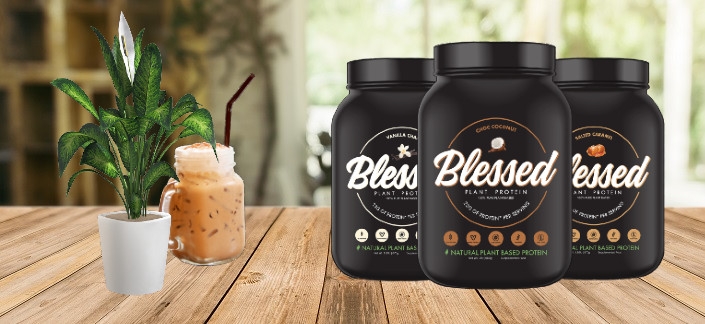
Blessed Protein is a pure plant-based powder based on a sprouted, raw and activated pea protein isolate. This product was released by Clear Labs, a sister company of the world-famous EHP Labs who offer a range of fitness and sports nutrition products.
Blessed Protein by Clear Labs can be taken any time of the day, including after exercise or before bed. Because legumes, like the golden peas used in this product, are low in an essential amino acid called methionine, it is often assumed that pea protein must be mixed with another plant protein rich in methionine (1).

However, when it comes to exercise performance and body composition, research is indicating that pea protein packs plenty of nutritional punch on its own. In fact, a recent clinical trial indicates that the results equal those delivered by whey protein (2).
This is the first clinical trial on any plant protein powder looking at markers of exercise performance. And the results are more than promising, showing that pea protein delivers exceptional nutritional support when it comes to force production and strength.
Is Blessed Protein Gluten Free?
Yes, Blessed Protein is free from Gluten containing ingredients. In addition, the manufacturing line where this protein is made does not process gluten-containing ingredients.
Is Blessed Protein Truly 100% Vegan?
Blessed Protein is manufactured in a state of the art facility with a production line of its own. Blessed Protein does not come into contact with any animal or dairy products of any kind.
Is Blessed Protein Organic?
Though Blessed Protein is made from 100% natural ingredients, it is not Certified Organic.
Is Blessed Protein Keto-Friendly?
Yes, each serve of Blessed Protein contains a minimal amount of glycemic carbohydrates. That is, the total carbohydrates after deducting the fibre content, as is the case with all North American nutrition panels.
Each serve of Blessed Protein (all flavours) contains 2 grams of carbohydrates (non-fibre), which is fine for use once or twice daily on most ketogenic dietary programs.
Benefits of Natural Sweeteners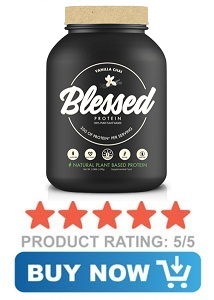
In the beginning, when protein powders were few and far between on the shelves of health food stores, artificial sweeteners reigned supreme.
If you wanted to find a protein powder without chemicals in the late nineties, odds are you would end up with an unflavoured product, some cocoa powder and hopefully a whole heap of resolve.
Fortunately, Australian sports nutrition companies soon threw on their lab coats and got to work in their research and development labs. Before long, thaumatin and xylitol appeared on the shelves in flavoured protein powders, plastering smiles on the faces of health conscious gym goers.
Finally, we could enjoy chocolate and vanilla shakes without chemicals. Hooray for naturally-flavoured protein!
Stevia soon followed and was approved for use in food and beverage by Food Standard Australia and New Zealand in 2008.
The naturally-sweetened protein powder market soon exploded as natural flavour combinations and all kinds hit the market.
Other natural sweeteners followed suit. Now we have monk fruit, fruit sugar concentrates and a range of sugar-alcohols, such as mannitol and sorbitol.
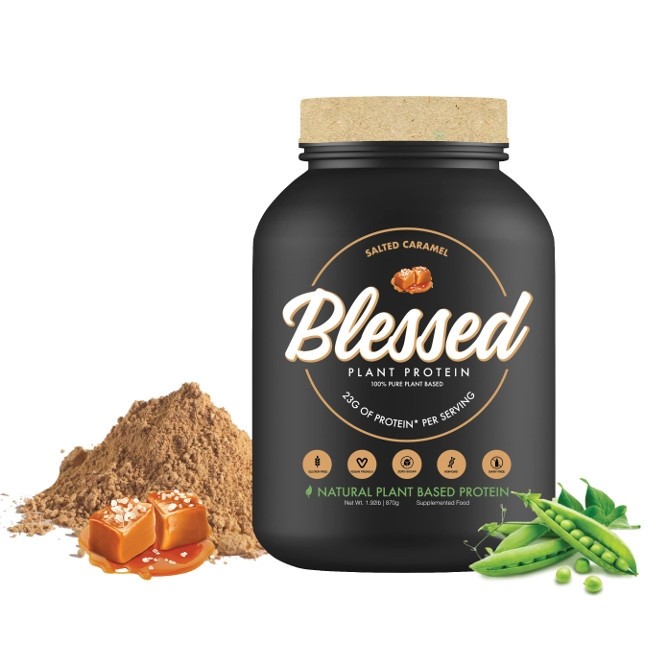
But it hasn’t all been peachy. Though Stevia was unquestionably sweet, it delivered a less “clean” sweetness than regular sugar artificial sweeteners and was disliked by some. This led to the introduction of stevia extracts, like the rebaudioside A found in this product.
Though sugar alcohols, like xylitol, are natural, they were avoided by some due to their laxative effects. However, research in 2016 indicated that a single dose of 10-30 grams did not cause digestive disturbances in healthy individuals (3).
Dental journals also began publishing findings relating to xylitol’s ability to improve oral hygiene. This led to xylitol finding its way into toothpastes and a range of oral hygiene products.
Sucralose: Bitter-Sweet or just really Sweet?
Okay, so there’s nothing actually bitter about sucralose when it comes to taste. In fact, it tastes very similar to regular old-fashioned processed sugar cane, with one little difference—it’s been chemically fashioned from chlorine and sucrose, and is 1,000 times sweeter than white sugar!
And that’s the same chlorine we put in our swimming pools to prevent algae growth. Due to the sweetness intensity of sucralose, only tiny amounts are used to achieve the same sweetness as sugar.
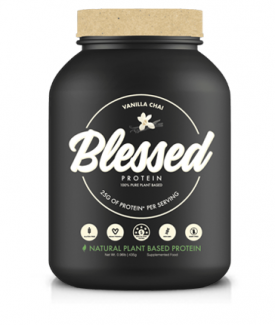 One of the big selling points for this sweetener is that we aren't supposed to be able to absorb it. Well, completely healthy people aren’t supposed to anyway.
One of the big selling points for this sweetener is that we aren't supposed to be able to absorb it. Well, completely healthy people aren’t supposed to anyway.
Given the prevalence of digestive disorders and “leaky gut”, it’s likely that many of us do absorb sucralose into our system. Research has shown that on average we excrete approximately 96.7% of sucralose and retain the rest.
Around 14.5% of the excreted portion is removed from the body via the urine, which indicates that we absorb at least 14.5% into the bloodstream—which is 14.5% more than we are supposed to be able to absorb (4).
With EHP Labs Blessed Protein Powder, however, we don't have to worry. It is 100% artificial sweetener free and contains only natural flavours.
Sucralose is one of the most popular artificial sweeteners in Australia and bears the code “Sweetener 955”. This sweetener is found in a range of products, though predominantly in sports nutrition products along with another Acesulfame-Potassium.
Acesulfame Potassium: Opponent of our GUT Microbiome
Acesulfame-Potassium (Ace-K) is commonly found in a range of protein powders, along with Sucralose. This zero-calorie artificial sweetener was accidentally discovered in 1967 by a German Chemist called Karl Clauss.
Ace-K is 200 times sweeter than sugar and may be found as “Sweetener 950” on ingredients labels. Despite the fact that this sweetener has been deemed safe, recent research indicates it can have some detrimental effects on long-term health.
So many chemicals and compounds are assessed purely based on short term safety. It’s impossible to properly assess long-term risk when using short term studies.
And how many markers and risk factors truly need to be taken into consideration when assessing the long-term safety of a chemical or nutrient?
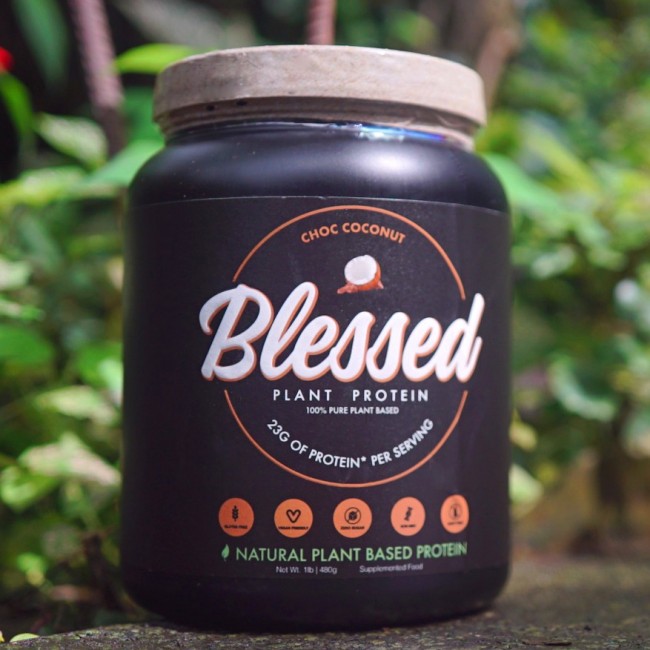
Certainly more than we are currently aware of. Despite this, there is a large gap between known risk markers and those taken into consideration for a chemical safety assessment.
Ace-K has been shown to disturb the gut microbiome, which are the healthy bacteria that live in our digestive tract (5). Our understanding of the impact of the microbiome on our health is in its infancy. But we do know it has a profound impact on health and wellbeing, and can even impact mood.
A study indicated that Ace-K may lead to weight gain, while artificial sweeteners in general may contribute to glucose intolerance (6). Glucose intolerance contributes to the development of type II diabetes and also contributes to fat gain.
It’s definitely a good thing that Blessed Protein powder contains only natural sweeteners, which are stevia and the stevia extract rebaudioside A!
Blessed Protein Ingredients
Bless this plant-based protein powder, as it contains nothing artificial! Apart from the foundational ingredient sprouted pea protein isolate, there are some other natural ingredients that we will take a quick look at.
A small amount of sunflower oil creamer, inulin fibre and gum arabic is added to each of the flavours. These are presumably added to improve texture and mouthfeel. Gums are natural fibres that lend thickness to a drink, while oils and creamers tend to improve mouthfeel.
Psyllium seed powder has been added to complement the naturally occurring fibre in the pea protein and the gums. Psyllium seed husks are a great source of soluble and insoluble fibre, and help to improve satiety.
Natural flavours and rock salt are also in the ingredients listing. While the flavours are added for obvious reasons, salt is a natural flavour enhancer.
Conclusion
EHP Labs have done a fantastic job creating this low calorie product, rich in plant-based protein. The flavour range is exceptional, particularly for those tired of standard chocolate and vanilla flavours.
When it comes to bioavailability, pea protein certainly holds its own, providing quality nutritional support for exercise performance and body composition.
The natural ingredients, including flavours and sweeteners, ensure that our total health is supported with every scoop. This really is a product that can be enjoyed long term as a health promoter or for helping you meet specific performance and body composition goals.
References








